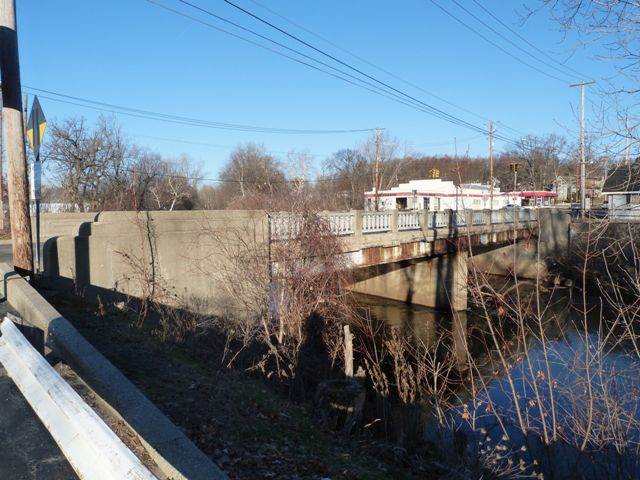We Recommend:
Bach Steel - Experts at historic truss bridge restoration.
BridgeHunter.com Phase 1 is released to the public! - Visit Now
Michigan Avenue Bridge

Primary Photographer(s): Nathan Holth
Bridge Documented: December 26, 2011
Hastings: Barry County, Michigan: United States
1949 By Builder/Contractor: Ruckman-Hansen, Inc. of Fort Wayne, Indiana and Engineer/Design: Foster Engineering Company
Not Available or Not Applicable
48.0 Feet (14.6 Meters)
97.8 Feet (29.8 Meters)
40 Feet (12.19 Meters)
2 Main Span(s)
084304400035B01

View Information About HSR Ratings
Bridge Documentation
This bridge no longer exists!
View Archived National Bridge Inventory Report - Has Additional Details and Evaluation
This historic bridge was demolished and replaced in 2012!
View Original Plan Sheets For This Historic Bridge
This bridge is a steel stringer that displays interesting aesthetic details that are very uncommon on bridges of this type. The bridge does display Michigan's Type R4 railing panels, the typical railing for this period. However, the concrete railing posts substitute the typical decorative keyhole shaped detail for a different design only found on a few bridges in Michigan. The abutments also feature decorative design including decorative parapets that rise above the deck level to form a continuation of the guardrail system. The overall design of these abutments can be found on a small number of bridges elsewhere in the state, but the detailing on the inside of the parapets may be unique. The pier for the bridge also abandons the typical aesthetic details for bridges of this type and uses a design that matches the style of the abutments. The bridge has a skew of fifteen degrees. Immediately north of the bridge, Mill Street intersects the road with a T intersection, leading eastward. The design of the northeastern abutment parapet accommodates this intersection with a curved design not found on the other three abutment parapets.
For comparison, a bridge that has some but not all of the unusual details of this bridge can be found in Macomb County..
Unfortunately, Hastings has decided to demolish and replace this attractive and distinctive bridge with a mundane pre-stressed concrete box beam bridge. An attempt to make this visually ugly type of bridge look less than ugly has been made by adding Texas rail, a modern concrete barrier that is designed to simulate concrete a design of balustrade railing that was common on historic bridges in Texas and some other states like Indiana. Michigan's old and historic bridges never had a railing similar to this design. The short period where concrete balustrade railings were used in Michigan saw a more open and ornate design of balustrade. As such, the Texas rail is out of context in this location. If Hastings wished to make this replacement bridge look like a historic bridge, they should have looked to the beautiful bridge they decided to destroy. The city could have instead reused the existing type R4 railing panels, and replicated the concrete post design of the historic bridge. The abutment parapets could also have been replicated. To provide a safe, crash-tested barrier, steel "two-tube" railing would be mounted in front of these railings. This process has been employed elsewhere in Michigan.
The previous bridge at this location was a metal seven panel pin-connected Pratt through truss.
Above: Historical Postcard of Previous Bridge
Source: Donald Harrison, http://www.flickr.com/photos/upnorthmemories/6092383123/, CC BY-NC-ND 2.0
![]()
Photo Galleries and Videos: Michigan Avenue Bridge
Bridge Photo-Documentation
Original / Full Size PhotosA collection of overview and detail photos. This gallery offers photos in the highest available resolution and file size in a touch-friendly popup viewer.
Alternatively, Browse Without Using Viewer
![]()
Bridge Photo-Documentation
Mobile Optimized PhotosA collection of overview and detail photos. This gallery features data-friendly, fast-loading photos in a touch-friendly popup viewer.
Alternatively, Browse Without Using Viewer
![]()
Maps and Links: Michigan Avenue Bridge
This historic bridge has been demolished. This map is shown for reference purposes only.
Coordinates (Latitude, Longitude):
Search For Additional Bridge Listings:
Bridgehunter.com: View listed bridges within 0.5 miles (0.8 kilometers) of this bridge.
Bridgehunter.com: View listed bridges within 10 miles (16 kilometers) of this bridge.
Additional Maps:
Google Streetview (If Available)
GeoHack (Additional Links and Coordinates)
Apple Maps (Via DuckDuckGo Search)
Apple Maps (Apple devices only)
Android: Open Location In Your Map or GPS App
Flickr Gallery (Find Nearby Photos)
Wikimedia Commons (Find Nearby Photos)
Directions Via Sygic For Android
Directions Via Sygic For iOS and Android Dolphin Browser
USGS National Map (United States Only)
Historical USGS Topo Maps (United States Only)
Historic Aerials (United States Only)
CalTopo Maps (United States Only)




